Kitchens provide a warm, welcoming space where everyone can come together to cook, eat, and share stories. Whether it's cooking a holiday dinner, baking cookies with the kids, or preparing meals for restaurant customers, the kitchen fosters connection and togetherness.
However, there are also numerous dangers, both in home and commercial kitchens. The most common accidents involve slips, burns, scalds, fires, and lacerations. These can lead to serious injury and even death.
At CopperSmith, we’ve put together 10 kitchen accident statistics to inform you of common dangers and how to avoid them.
1. In the U.S., 160,000 children are injured in kitchen accidents each year
This represents .22% of the U.S. population under age 18. However, that rate is more than double in the United Kingdom, where 67,000 children or .47% of the under-18 population is injured in the kitchen each year.
Children are especially vulnerable to injury in kitchen accidents. In fact, the kitchen is the third most common location for accidents for children under 14.
Kids aged 5 and younger are at the most risk of burns, with 43% of burns among children being caused by hot liquid or food. Approximately 60% of scald burns in children occur in the home.
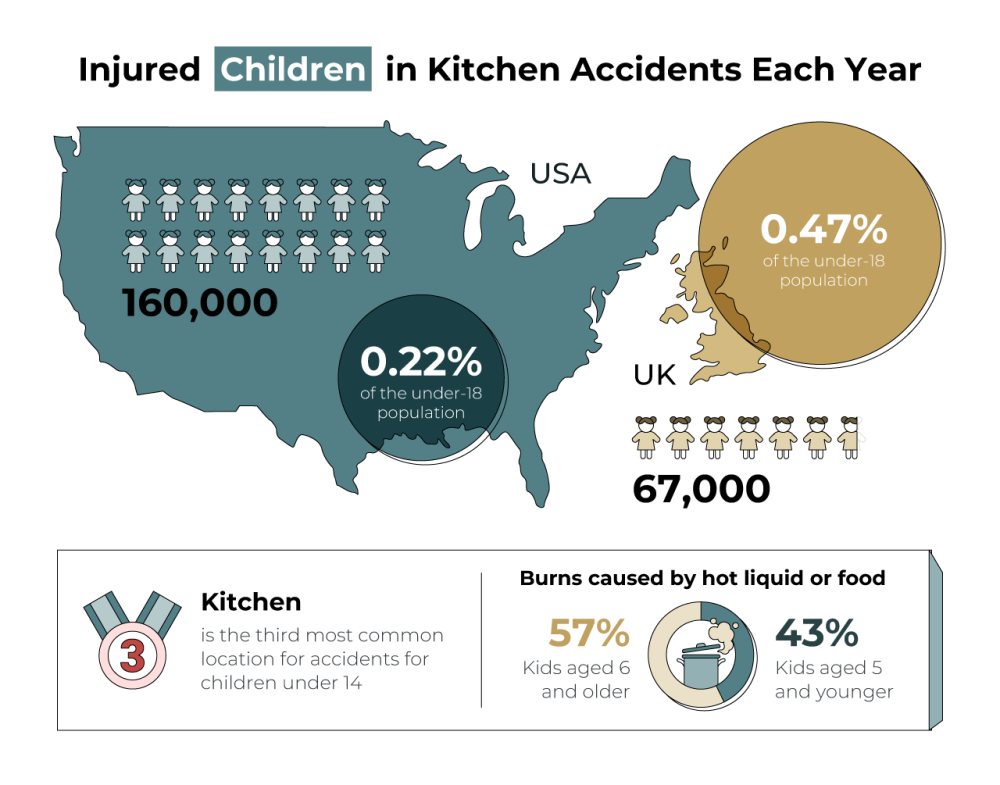
2. Roughly 200,000 kitchen accidents result in emergency room visits in the U.S. each year
By some estimates there are roughly half a million kitchen accidents in the U.S. each year, or approximately 1,300 accidents per day, including accidents that don’t require medical attention.
The most common types of kitchen accidents include fires, burns, cuts, lacerations, and slip-and-falls due to wet floors. We’ll discuss each of those in greater detail in this article, but the following is a breakdown of injuries caused by lesser known factors documented over a 12-month period in the U.S.
- Ranges: 40,000 injuries involving ovens and cooktops, including unsupervised children who climbed on the oven door and caused the range to tip over.
- Cookware: 37,000 injuries, including cuts from shattered equipment and burns from hot handles.
- Food processors: 21,000 injuries, including cuts from slicer or chopper blades.
- Microwaves: 10,000 injuries, the majority of which were burns.
- Blenders: 9,600 injuries, a large portion of which were caused by increasingly popular immersion blenders.
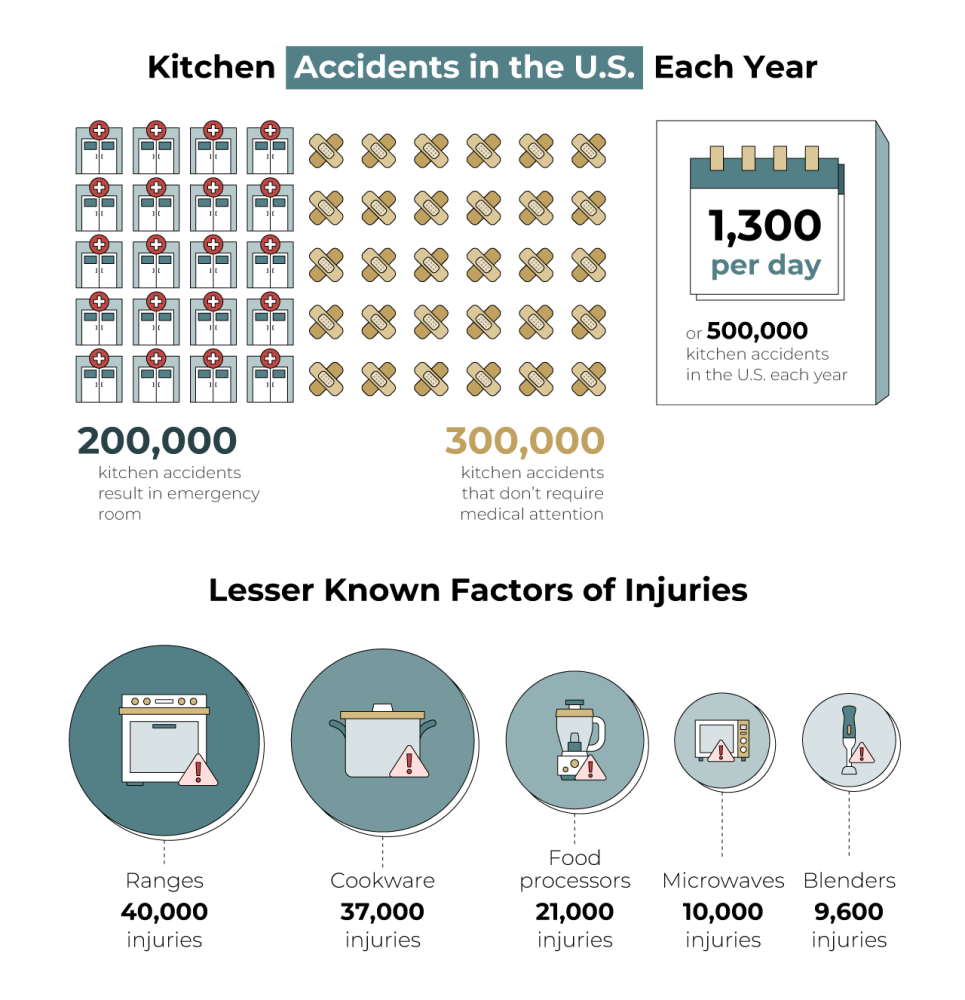
3. Cooking causes 44% of home fires
According to kitchen fire statistics, fire department personnel responded to 178,600 cooking fires in homes within a 12-month period. For comparison, here are the other leading causes of home fires:
- Heating fires: 34,800
- Accidental fires (other): 33,000
- Electrical malfunction fires: 26,100
As indicated by this data, accidental cooking fires far outnumber other causes of residential fires.
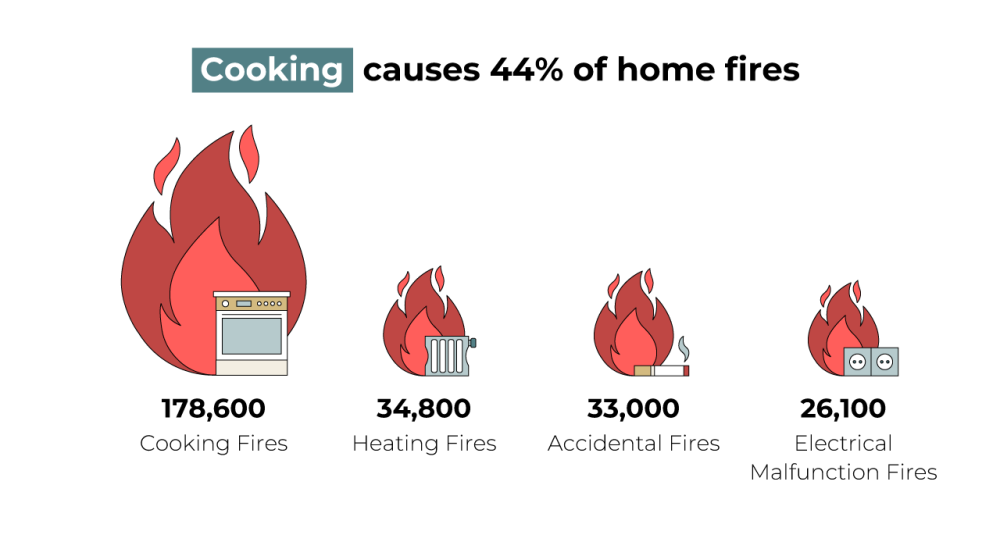
4. Kitchen knives injure 350,000 people annually
Lacerations are a leading result of kitchen accidents, both at home and in commercial kitchens. One study found that 18% of chefs incurred cuts and lacerations. This type of injury was most common in fast food kitchens, with 27% of cooks in that setting reporting cuts and lacerations, compared to 22% of cooks in full-service restaurants and 8% of cooks in catering centers.
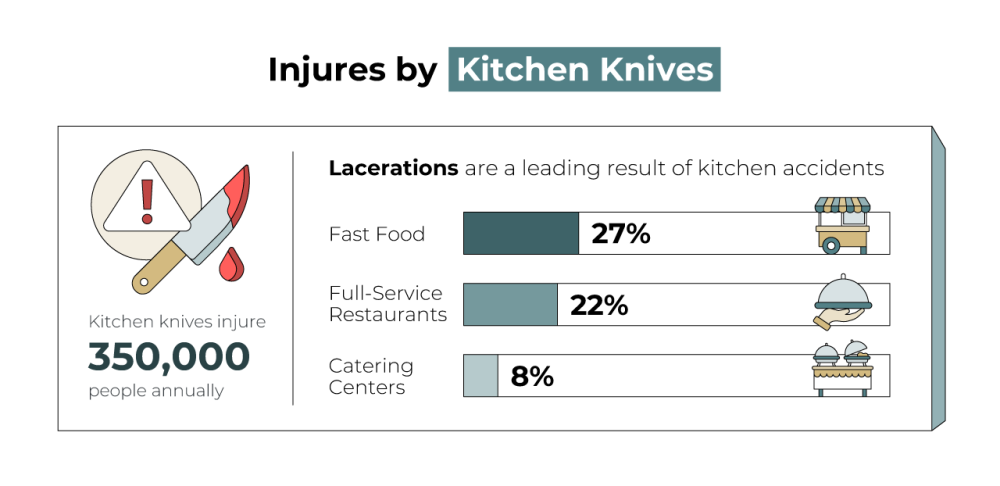
5. Workers in restaurants are more likely to experience burns, cuts, and lacerations than in any other industry
According to a report from the Bureau of Labor Statistics, workers in full-service restaurants experienced a total of 93,800 non-fatal injuries and illnesses over the course of one year. Of these, approximately 33% were serious enough to result in days away from work.
Restaurant workers, exposed to kitchen hazards, had significantly more burns, cuts, and lacerations than workers in other private industries. Within a 12-month period, they experienced 8,110 cuts and lacerations that resulted in missed work
This occurred at a rate of 23.6 cases per 10,000 full-time employees. For comparison, the rate across all private industries was less than a third of that, at only 7.1.
Meanwhile, restaurant workers incurred burn injuries at a rate of 10.2 per 10,000 workers, nearly seven times the rate of workers across all private industries (1.5).
However, due to the nature of common kitchen accidents, restaurant workers incurred soreness and pain at a lower rate than the workers across all private industries, at 12.1 vs. 15.4. Same for sprains, strains, and tears at 16.3 vs. 28.9.
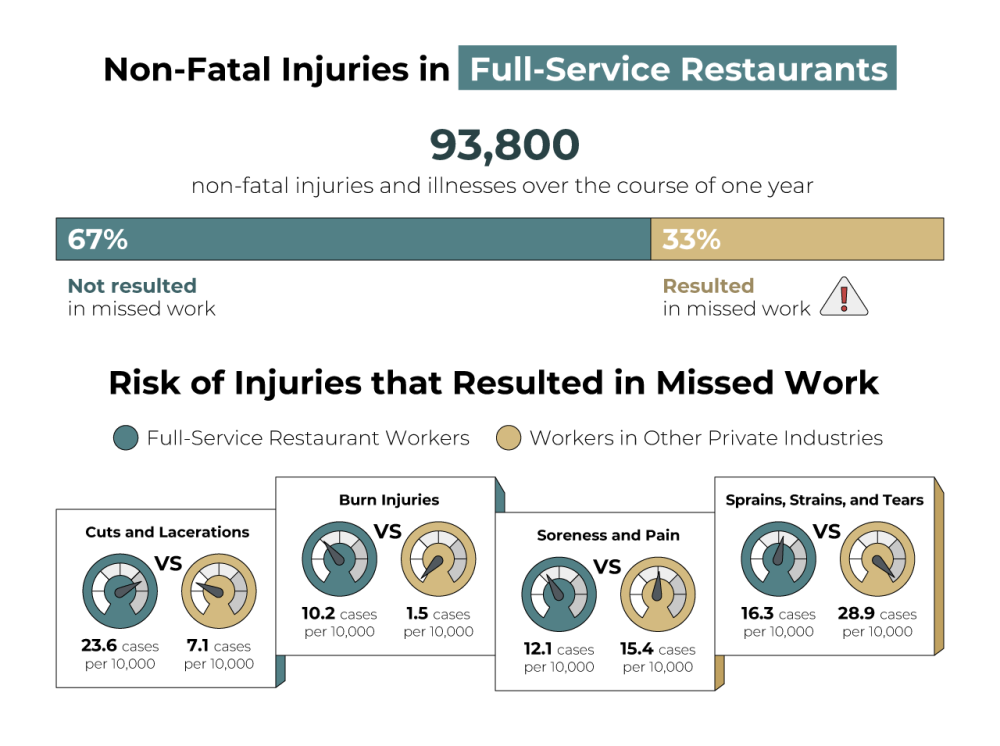
6. Slip-and-fall accidents are a major risk in commercial kitchens
Commercial kitchens typically are divided into dry kitchens and wet kitchens:
- In dry kitchens, workers chop vegetables, arrange ingredients, plate dishes, make salads and sandwiches, and perform other food preparation tasks that don’t involve heavy cooking or the use of water.
- In wet kitchens, workers wash and prepare raw ingredients, cook using stoves, ovens, and other appliances, and manage dishes that require boiling, frying, or steaming.
In dry kitchens, 61.5% of food service workers report slip-related accidents occurring once or twice per year. However, in wet kitchens, 67% of workers said these accidents occurred at least once per month.
Slippery floors are a clear contributor to the high rate of workplace injuries in wet kitchens. In dry kitchens, 40% of workers reported the floor being slippery at least once per week, compared to 92% of wet kitchen workers.
In dry kitchens, 30% of workers report never experiencing an accident due to a slippery floor, while 25% of workers in wet kitchens said the same.
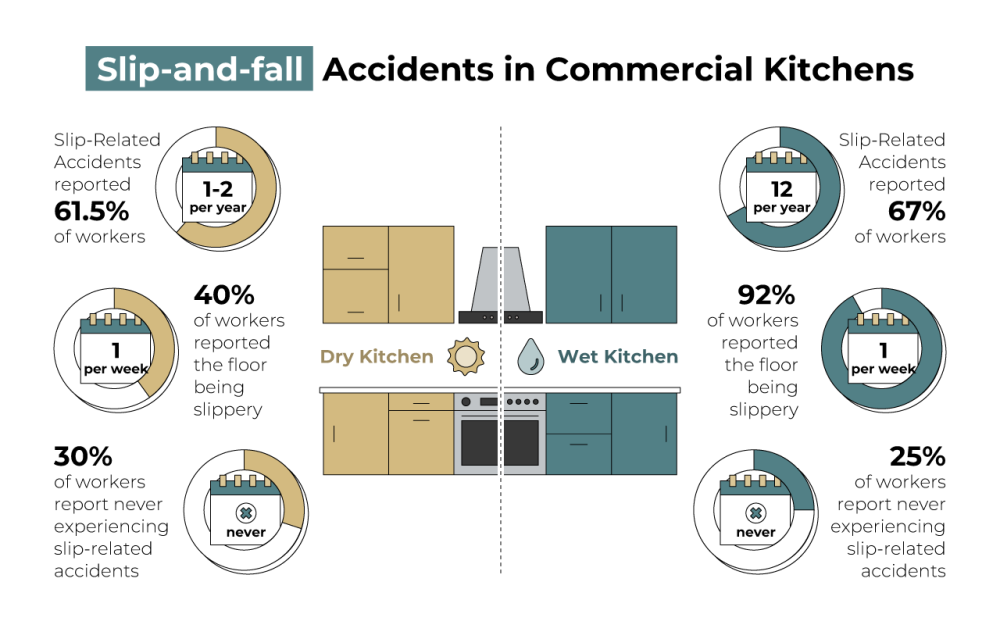
7. Accidental kitchen fires are the leading cause of fire injuries and fatalities for U.S. homeowners
Burns and smoke inhalation from kitchen fires cause 42% of home fire injuries in the U.S., injuring approximately 4,150 people annually. This makes kitchen fires the leading cause of fire injuries in the nation.
Additionally, kitchen fires lead to 470 home fire deaths each year, 18% of the total, and $1.15 billion in property damage. These figures do not include firefighter casualties.
Leading factors that contribute to kitchen fires include flammable cooking oils, heat, and nearby cooking materials and kitchen appliances that can cause a fire to spread quickly.
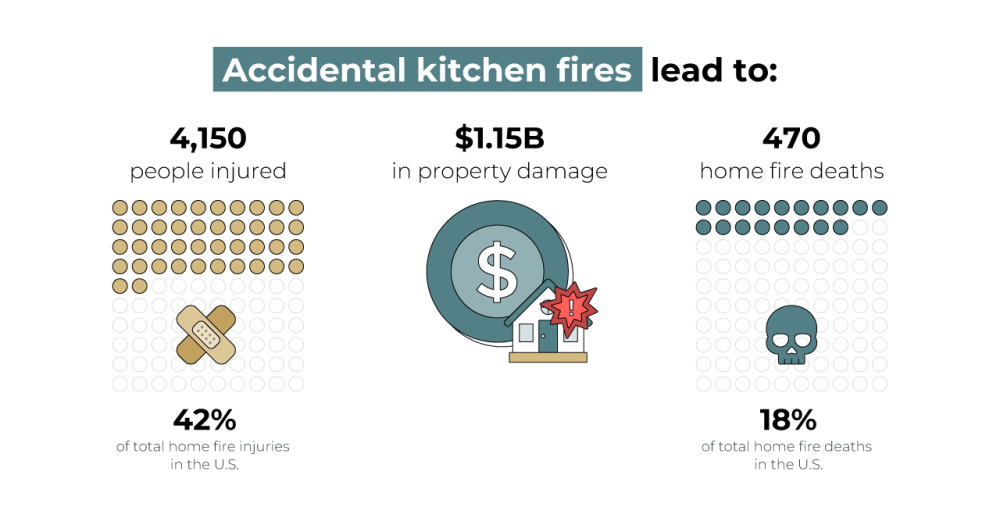
8. Unattended cooking causes the most home cooking fires and more than half of related deaths
According to Congress.gov, unattended cooking equipment causes 31% of kitchen fires in private residences. This factor also contributes to 53% of home kitchen deaths.
Here’s a breakdown of the other leading causes and related fatalities:
- Combustion of abandoned or discarded cooking material, including food: 10% of fires and 11% of deaths.
- Combustibles placed too close to heat sources: 9% of fires and 15% of deaths.
- Kitchen appliances accidentally turned on or not turned off: 8% of fires and 8% of deaths.
Additionally, misuse of kitchen materials leads to 9% of home cooking fires, and failure to properly clean materials leads to 8%.
Surprisingly, the majority of fatalities resulting from accidental kitchen fires occur in other parts of the house. Roughly two thirds of kitchen fire fatalities occur in other rooms, while people were sleeping or otherwise unaware that a fire had started.
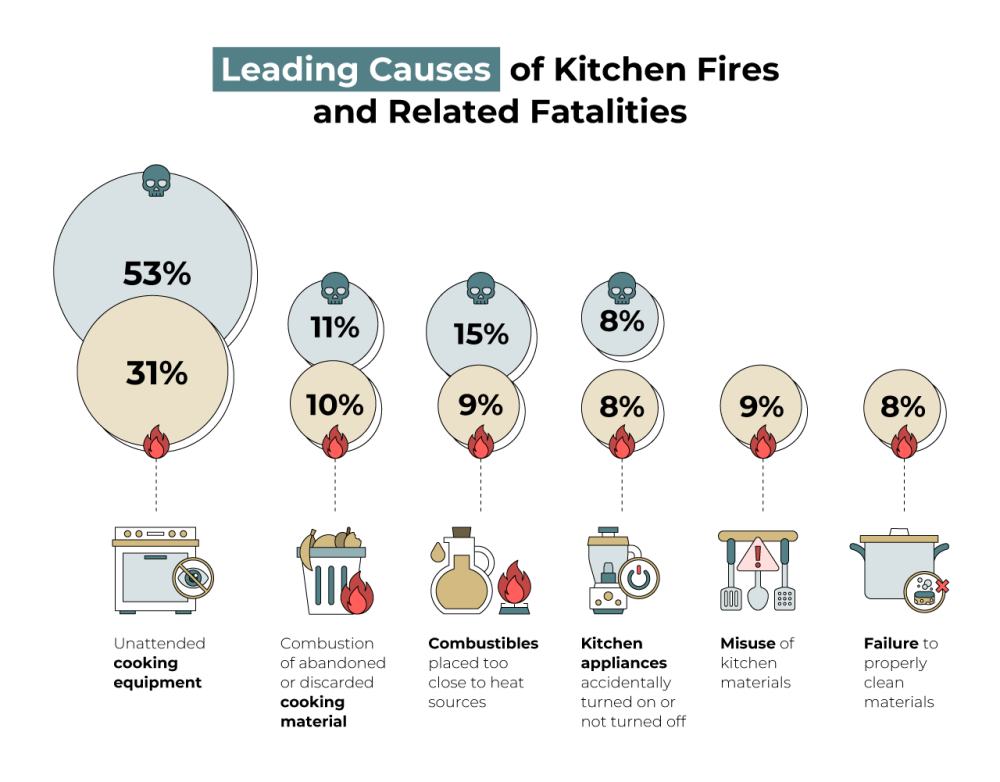
9. Each year, U.S. fire departments respond to 7,400 fires in commercial kitchens
This annual average includes accidental fires that started due to a wide range of causes, including gas stoves and ovens, worn-out plugs and frayed cords, overheating electrical cooking appliances, and overloaded outlets.
Here are some leading kitchen fire hazards that many overlook:
- Oven mitts, dish towels, and pot holders: Can catch fire if placed too close to the stovetop.
- Fryers: Especially hazardous fire risk if not properly cleaned and closely monitored.
- Grease traps: Can catch fire, particularly if not well maintained.
- Oily rags: Combustible fire hazard, particularly if placed near a heat source.
- Clouds of flour: Can catch fire near an open flame.
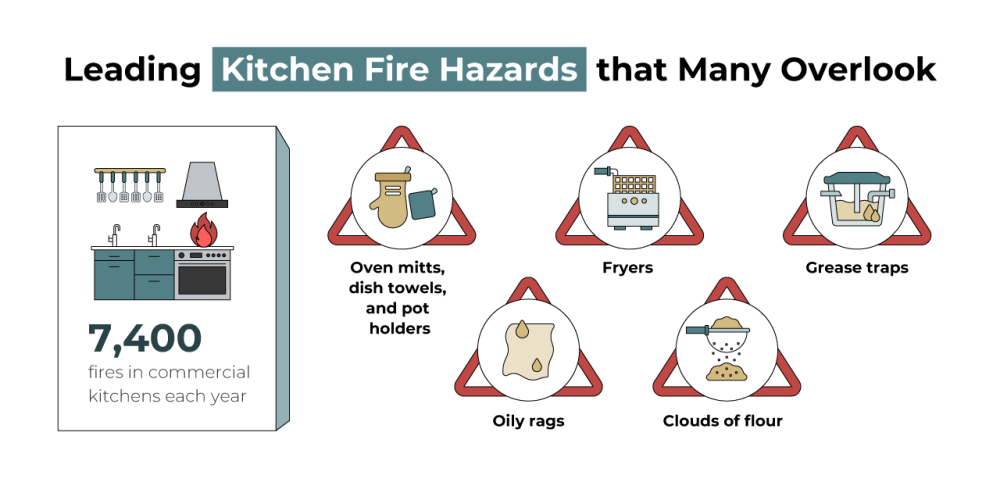
10. Approximately 19% of cooks report repetitive motion injuries
Accidental injury can occur over time rather than during an isolated incident. In a study of food service workers, nearly one in five cooks reported forearm and shoulder injuries due to repetitive motion. These injuries, specifically wrist and shoulder stiffness, were reported by 28% of cooks in restaurants, 14% of cooks in catering centers, and 14% of cooks in fast food establishments.
This indicates repetitive motion injuries are twice as prevalent in full-service restaurant kitchens than in other types of commercial kitchens.
Meanwhile, 14% of cooks reported body aches, primarily due to stirring large quantities of food. These were most common in catering centers, with 22% of cooks in that environment reporting this injury compared to 9% of cooks in restaurant kitchens and 2% of cooks who prepare fast food.
For comparison, in the same study 24% of cooks reported burn injuries, primarily caused by contact with hot oil and cooking vessels, 18% reported slips and falls, and 18% reported lacerations.
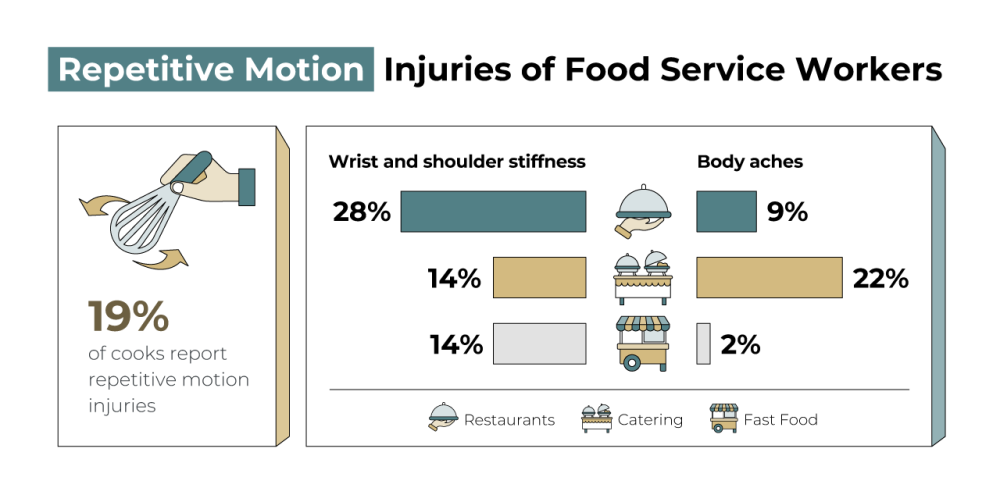
Kitchen Safety Tips
To reduce accidents in home and commercial kitchens, it’s important to maintain general kitchen safety protocols. Here are some preventative measures and tips for what to do if an accident occurs. Following these tips can help reduce kitchen accidents and related injuries:
Fires
- Never leave cooking unattended, especially when frying, broiling, or grilling. Cooking with a fryer, broiler, or grill requires constant supervision. While baking, simmering, or roasting, be sure to stay on the premises and check the food frequently. Setting a timer can help you remember.
- Install smoke alarms and test them frequently to ensure they are functioning.
- Keep combustible materials away from heat sources, including food packaging, oven mitts, kitchen towels, napkins, and pot holders.
- Never put water on a grease fire, as this will cause it to spread. Instead, smother it with a pan lid. Always keep a lid close so you can easily grab it, slide it over the pan, and turn off the stove.
- Do not open the oven door if a fire starts inside. Oxygen will feed the fire. Instead, leave the door closed and turn off the oven.
- Keep a fire extinguisher in the kitchen with a minimum rating of 5-B:C. Be ready to leave if the fire grows too big to control, and dial 9-1-1.
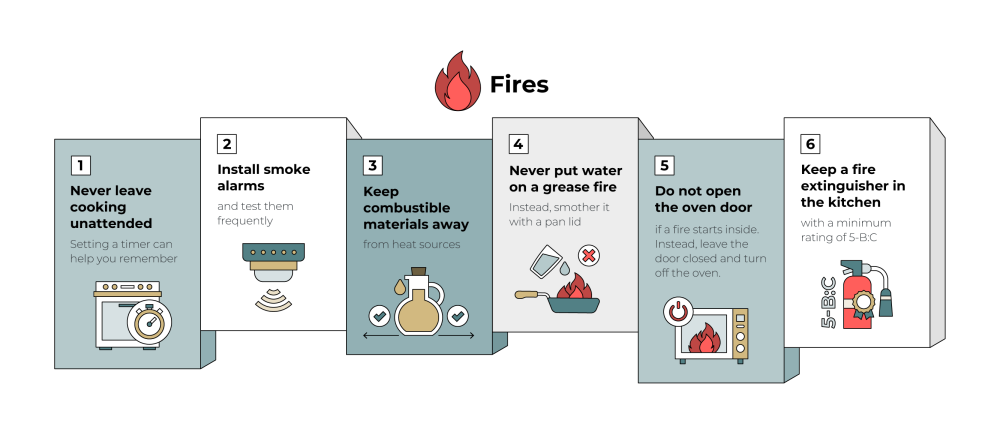
Burns and Scalds
- Don’t forget to use pot holders and oven mitts when handling pots, pans, and hot dishes.
- Keep oven mitts and pot holders dry, as steam can form when wet and scald your hand.
- For food service workers, warn co-workers when carrying hot items in the kitchen so they don’t bump into you.
- Use caution when unwrapping or uncovering a microwaved dish, as steam can build up and escape.
- Boil water on the stove instead of the microwave, as microwaved water can erupt.
- Be careful when touching or tasting microwaved food, as it can be heated unevenly and cause scalds.
- Install a bracket on your range to ensure it does not tip over.
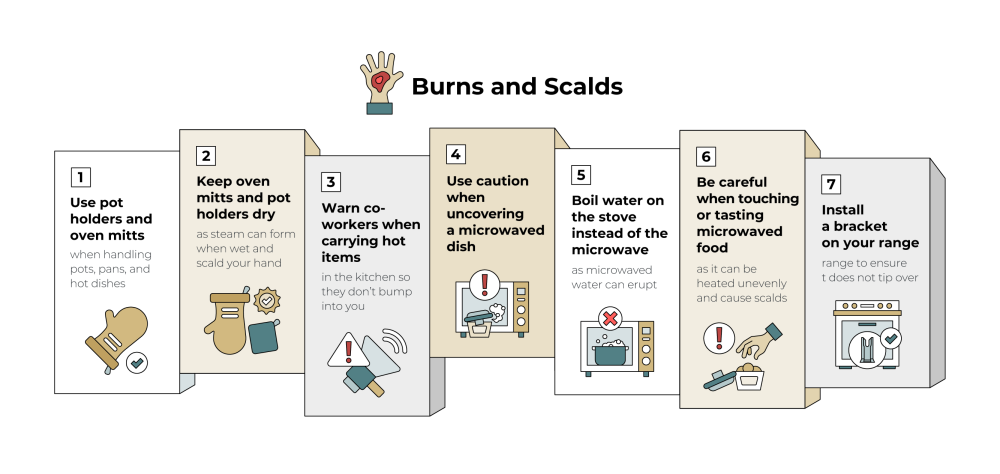
Cuts and Lacerations
- Always keep knives sharpened, as a dull knife is more dangerous than a sharp knife. This is because dull knives require more force to use and are more difficult to control.
- Wash choppers, and other food processors in the dishwasher – not by hand.
- Wash blenders by pouring in dishwashing detergent and hot water, then set it to high and run it for one minute. Then unplug and rinse.
- Never put your hand in a blender, as most don’t have safety locks.
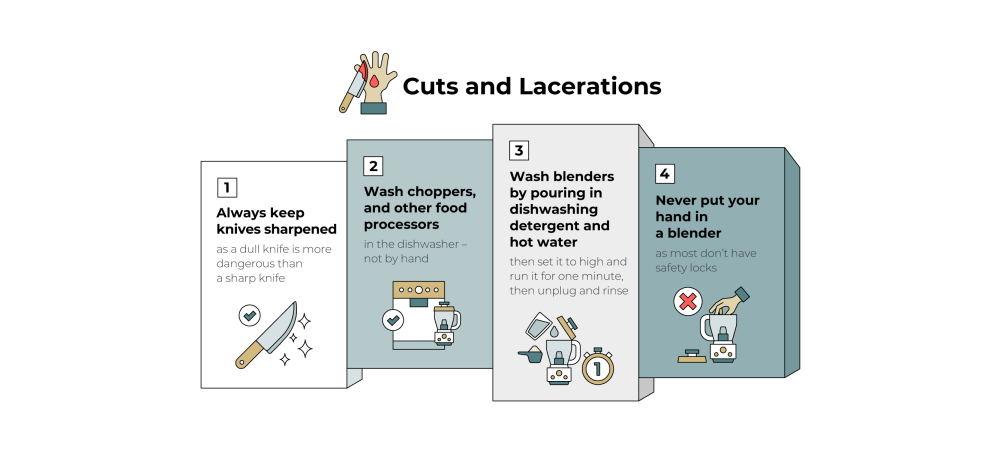
Slips and Falls
- Wear slip-resistant shoes in commercial kitchens, as the floors are frequently wet.
- Clean up spills immediately to prevent slips.
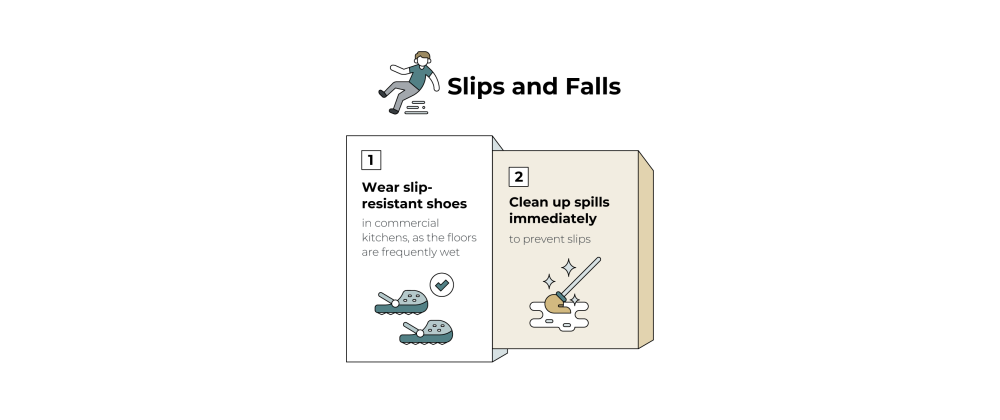
Repetitive Motion Injuries
- Use mixers and blenders rather than stirring everything by hand.
- Practice cardio, heel raises, calf stretches, shoulder shrugs, and wall squats to improve flexibility and condition the muscles for the strains and stresses of a commercial kitchen.
- Wear compression socks and supportive shoes.
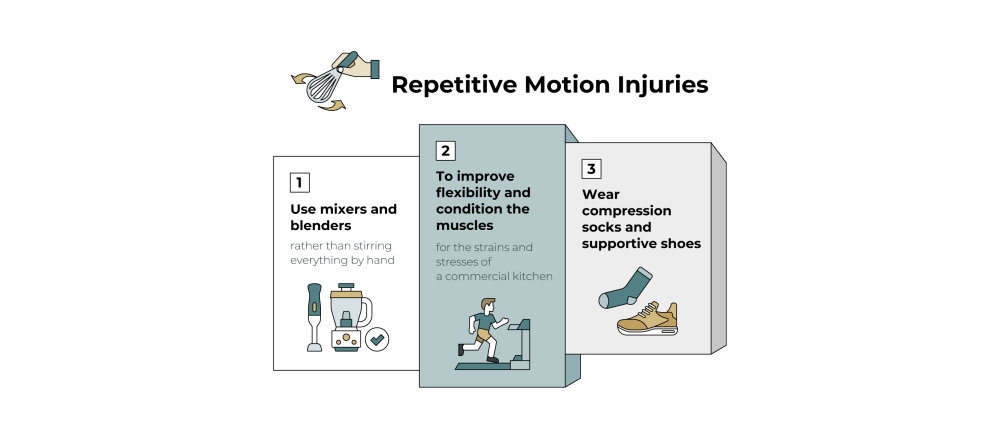
Shattered Cookware
- Don’t use chipped or cracked cookware.
- Don’t pour liquid into a hot dish or place it on a damp or cold surface, like a refrigerator shelf.
- Don’t move a dish straight from the oven to the freezer, or from the freezer to the oven.
- Don’t place glass cookware on a hot burner, in the oven, or under a broiler unless it’s designed for it.
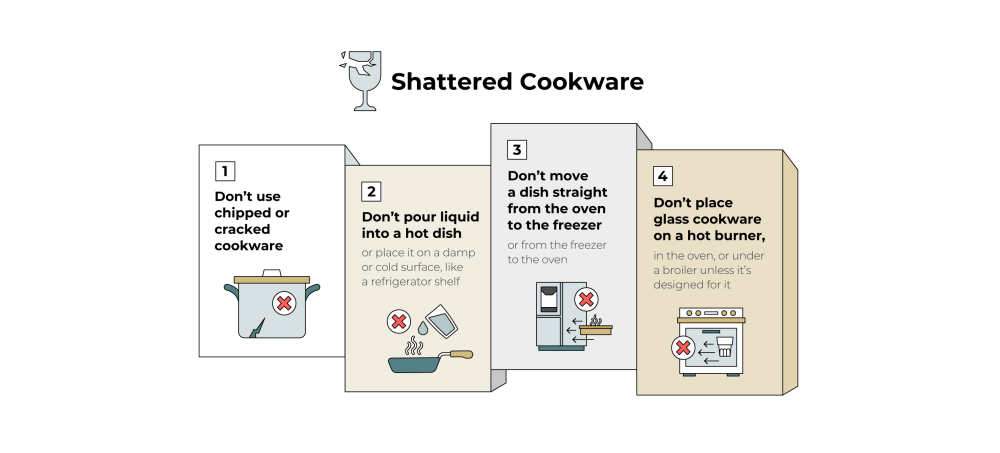
What These Kitchen Accident Statistics Reveal
The kitchen is an essential but potentially dangerous room in any home, restaurant, or catering establishment. However, by following general cooking safety rules, particularly fire safety protocols, risk factors can be mitigated.
This will help reduce severe injuries and fatalities, and ensure the kitchen is a place associated with positive things such as togetherness, wonderful smells, and delicious food.
FAQ
What is the most common cause of kitchen accidents?
Burns are among the most common kitchen accidents, often caused by hazards like hot liquids, cooking oil, and boiling water. To prevent burns, keep saucepan and skillet handles turned away from the stove’s front.
How many kitchen accidents happen each year?
More than 200,000 kitchen accidents occur annually in the U.S., leading to emergency room visits. Nearly 21 million medical visits each year result from unintentional home injuries, with slips, trips, and falls being the most frequent kitchen incidents.
Where are kitchen fires most common?
Massachusetts has the highest rate of cooking fires per capita, averaging 13,137 fires each year, or 188.2 fires per 100,000 residents.
What are the statistics for cooking safety?
The NFPA reports that about 61% of restaurant fires are caused by cooking, with equipment or materials being the primary items ignited, resulting in three out of five fires and 38% of direct property damage.
How many people cut themselves in the kitchen each year?
Kitchens can be dangerous, with two-thirds of home fires starting there, 480 deaths annually due to kitchen fires, and 350,000 people injured by kitchen knives each year.
What are the three main hazards in the kitchen?
The three primary kitchen hazards are biological, chemical, and physical threats, which are of great concern to food service managers and health inspectors.
What is the number one safety rule in the kitchen?
The most important kitchen safety rule is to wash your hands thoroughly. Use warm water and soap, and scrub for at least 20 seconds before handling any food.
What is the most common food safety issue?
Improper hand washing is a major food safety concern. Wet your hands with warm water, apply soap, and scrub for a minimum of 20 seconds to prevent foodborne illnesses.
Can most kitchen accidents be prevented?
While accidents happen, following simple safety measures can minimize risk. Rearrange your kitchen to keep frequently used items within easy reach and clear space on counters near the stove to safely set down pans.
What is the leading factor in home cooking fires?
Fire departments respond to over 170,000 home fires caused by cooking each year, with the leading cause being unattended cooking.
Why is cooking at home safer?
Safe food handling at home reduces the risk of foodborne illnesses. Home cooking can also improve mental sharpness, reduce cognitive decline, and promote healthy development in children.
Which cooking method is most likely to cause a kitchen fire?
Frying or broiling with oil is highly prone to kitchen fires, accounting for 66% of incidents where cooking substances like oil, fat, or butter catch fire.
What is the most obvious danger in the kitchen?
Common kitchen risks include fire, electrical issues, burns, slips, improper equipment use, food poisoning, and poor storage practices.
How can you avoid a kitchen fire?
To prevent kitchen fires, keep cooking equipment clean, avoid loose clothing, and keep combustibles away from heat sources. Always stay in the kitchen when cooking.
What is the Danger Zone in a kitchen?
The kitchen Danger Zone refers to temperatures between 40–140°F (4–60°C), where bacteria can grow rapidly. Keeping food out of this range is essential for safety.
How long can an oven stay on before catching fire?
If empty and set to a low temperature, an oven can generally be left on for up to 12 hours safely, provided it’s reliable and nothing flammable is nearby.
Do electric stoves cause more fires than gas stoves?
Electric stoves pose a higher risk of cooking fires compared to gas stoves. Although 60% of households cook with electricity, 80% of cooking fires involve electric ranges.
Why does fire catch easily in the kitchen?
The main fire risks in the kitchen include deep fat frying, distractions, and failing to turn off appliances when finished cooking.
What is the most effective way to prevent a kitchen fire?
Stay in the kitchen when frying, grilling, or broiling. If you need to leave, turn off the stove, and keep flammable items away from the cooking area.
What temperature kills bacteria in food?
Bacteria are only killed at temperatures of 165°F or higher. While cold temperatures slow bacterial growth, they don’t eliminate it.
How CopperSmith Can Help
Updating appliances and replacing faulty kitchen equipment can reduce the risk of cuts, lacerations, burns, scalds, and other injuries related to kitchen accidents.
For example, a high-quality exhaust fan or range hood from CopperSmith can improve ventilation and remove smoke and heat from the kitchen, helping prevent injury from smoke inhalation and making it easier to address emergencies effectively.
Choose from copper, stainless steel, and custom varieties to improve the aesthetics and safety of your kitchen.
